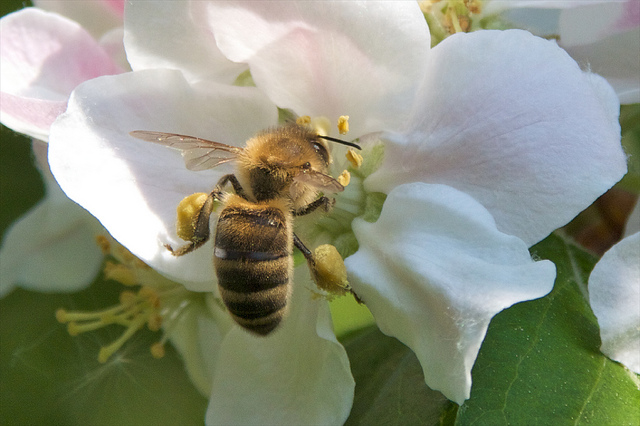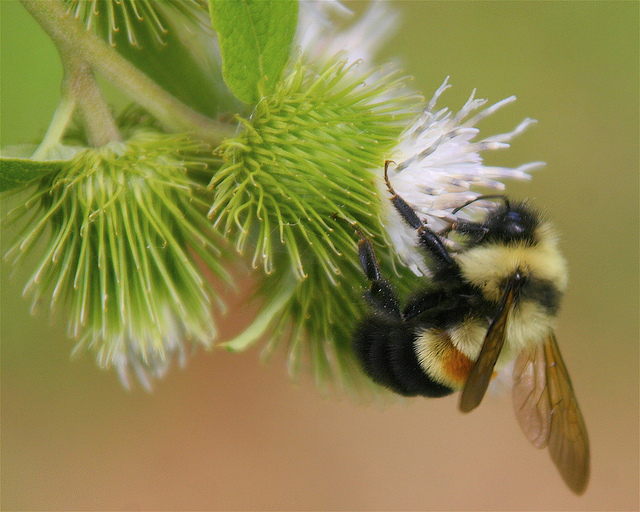By Amy Davidson
The media has been buzzing with talk of honey bees lately—and rightly so. These diligent little workers are an important part of the U.S. food system, contributing billions annually to U.S. crop production. They provide incredible, edible diversity and dynamic ecosystem supports. However, because of pesticide use, monoculture planting, habitat loss and disease, they are dying in record numbers. Just imagine what your plate, field, or forest might look like without these hardworking little creatures.

Focusing on honey bees, while important, doesn’t give us the full picture. There are about 3,500 bees native to the U.S. and about 250 of them are native to Vermont. As honey bee populations decline, we need to rely more heavily on these native bees for important economic, nutritional, and environmental contributions. They should be protected!
Researchers from UVM’s Gund Institute have been investigating native bee pollination of blueberries in parts of Chittenden and Addison Counties in Vermont. According to researcher Charlie Nicholson, the team is observing greater variation in the abundance and types of bees in landscapes that includes an assemblage of uses—pasture, forest, orchard, field, and stream. He says that this type of diversity in land-use promotes resilience in ecosystems. As one species suffers or declines, others are present and can continue to perform essential functions. Because of land-use diversity, Vermont bees are faring better than other places in the U.S. that have monoculture crops “as far as the eye can see.”
Sophia Bielenberg of High Mowing Organic Seeds in Wolcott, Vermont, acknowledges that although Vermont is doing a better job of supporting bees than many places, “it isn’t perfect.” She has observed a decrease in pollinator populations, like the rusty patched bumble bee, which is now under threat of extinction. So, what can we all do to help our bee populations thrive?

One might think that acquiring and thoughtfully managing a colony of bees might be one solution. Surprisingly, none of the folks I talked to suggested we all become hobbyist beekeepers. Instead, they recommend we raise awareness and establish good forage and habitat supports for bees on our own properties. One way to do this—stop being so darn tidy!
- Let the flowers grow—not just the ornamental kind that look great while offering little in the way of bee nutrition, but wild flowers, says Sophia Bielenberg. [Visit The Xerces Society for a list of flowering plants native to your area]. Native bees need native pants. Often this just means allowing some portion of land or lawn to become field or forest.
- The size of your lawn counts. It should be “more like an area rug than wall to wall carpeting,” says UVM PhD student Annie White.
- Also, just let it grow. Beekeeper Amy Walker recommends we not be so diligent mowing our lawns—to “leave the dandelions… and white clover, and grow a row along the edge of lawn for pollinators.” These practices help ensure forage for bees all season long.
- Leave those brush piles and old stumps in their place. They provide great nesting sites for bees. Too tidy to leave brush scattered about? Consider making a bee post, house or hotel.
- Provide a clean water source. Without one readily available, bees will have to fly off in search of water. Sophia Bielenberg suggests setting out a large dish of water with stones in it for bees to stand on.
- Stop using pesticides and herbicides on lawns, gardens, and ornamental trees, flowers and shrubs. Amy Walker says we need to “stop selling and using large amounts of pesticides…it’s bad for kids and bees.” Educate yourself about pesticides and ways to reduce their use.
These are such simple things that all of us can do to mitigate the damage caused by unsustainable agriculture and land-use practices. There really is no excuse for not taking action to preserve and protect these tiny insects that have such a huge impact on the world we live in.
Amy Davidson is coordinator of UVM Extension’s Expanded Food and Nutrition Education Program (EFNEP) and a masters student in the UVM Food Systems Graduate Program. She wrote this as part of the 2014 UVM Breakthrough Leaders Program for Sustainable Food Systems.
Photo credits:
Bee on apple blossom by Steve Roberts via Flickr CC BY-NC-ND 2.0
Rusty-patched Bumble Bee by Dan Mullen via Flickr CC BY-NC-ND 2.0










